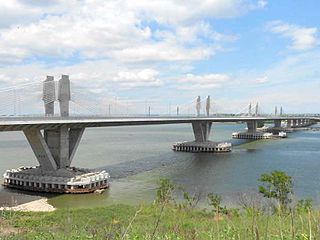
Galați is the capital city of Galați County, in the historical region of Western Moldavia, in eastern Romania. Galați is a port town on the Danube River. It has been the only port for the most part of Moldavia's existence. In 2011, the Romanian census recorded 249,432 residents, making it the 8th most populous city in Romania. Galați is an economic centre based around the port of Galați, the naval shipyard, and the largest steel mill in Romania, Galați steel works.

Dolj County is a county (județ) of Romania on the border with Bulgaria, in Oltenia, with the capital city at Craiova.

Vidin is a port town on the southern bank of the Danube in north-western Bulgaria. It is close to the borders with Romania and Serbia, and is also the administrative centre of Vidin Province, as well as of the Metropolitan of Vidin.

Drobeta-Turnu Severin, colloquially Severin, is a city in Mehedinți County, Oltenia, Romania, on the northern bank of the Danube, close to the Iron Gates. "Drobeta" is the name of the ancient Dacian and Roman towns at the site, and the modern town of Turnu Severin received the additional name of Drobeta during Nicolae Ceauşescu's national-communist dictatorship as part of his myth-making efforts.

Sulina is a town and free port in Tulcea County, Northern Dobruja, Romania, at the mouth of the Sulina branch of the Danube. It is the easternmost point of Romania.

Calafat is a city in Dolj County, southern Romania, in the region of Oltenia. It lies on the river Danube, opposite the Bulgarian city of Vidin, to which it is linked by the Calafat-Vidin Bridge, opened in 2013. After the destruction of the bridges of late antiquity, for centuries Calafat was connected with the southern bank of the Danube by boat, and later on by ferryboat.
The Danube is the second longest river in Europe.

Kozloduy is a town in northwest Bulgaria, located in Vratsa Province, on the Danube River. The city was liberated from Ottoman rule on 23 November 1877 by the Romanian Army under the command of the Imperial Russian Army. Kozloduy is best known for the Kozloduy Nuclear Power Plant, Bulgaria's only nuclear power plant, which is located nearby, as well as the second-largest Bulgarian Danubian island, Kozloduy Island. The city is also known for the ship Radetzky, the boat in which the poet and revolutionary Hristo Botev and with 200 others crossed the Danube River in a final attempt to gather an army and liberate Bulgaria from the Ottoman Empire.

The Danube Bridge is a steel truss bridge over the Danube River connecting the Bulgarian bank to the south with the Romanian bank to the north and the cities of Ruse and Giurgiu respectively. It is one of only two bridges connecting Romania and Bulgaria, the other one being the New Europe Bridge between the cities of Vidin and Calafat.

The Italians in Romania are people of Italian descent who reside, or have moved to Romania.

The Proclamation of Islaz was the program adopted on 9 June 1848 by Romanian revolutionaries during the Wallachian Revolution of 1848. It was written by Ion Heliade Rădulescu and publicly read at the small port town of Islaz in southern Wallachia. On 11 June, under pressure from the masses, Domnitor Gheorghe Bibescu was forced to accept the terms of the proclamation and recognise the provisional revolutionary government.

The New Europe Bridge is a road and rail bridge between the cities of Vidin, Bulgaria, and Calafat, Romania. It is the second bridge on the shared section of the Danube between the two countries. It is an extradosed bridge and was built by the Spanish company Fomento de Construcciones y Contratas, at the cost of €226 million. It was officially opened with a ceremony held on 14 June 2013. The first vehicles were allowed to cross the bridge after midnight, on 15 June 2013.

Bulgarian-Romanian relations are foreign relations between Bulgaria and Romania. Bulgaria has an embassy in Bucharest. Romania has an embassy in Sofia and three honorary consulates. There are 7,336 Bulgarians who are living in Romania and around 4,575 Romanians living in Bulgaria. The countries share 608 km of common borders, mostly along the Danube.

The Danube is the second-longest river in Europe, after the Volga in Russia. It flows through much of Central and Southeastern Europe, from the Black Forest into the Black Sea. Its longest headstream Breg rises in Furtwangen im Schwarzwald, while the river carries its name from its source confluence in Donaueschingen onwards.

The Port of Cǎlǎrași is one of the largest Romanian river ports, located in the city of Călărași on the Danube River.

The Corridor IV is one of the Pan-European transport corridors. It runs between Dresden/Nuremberg in Germany and Thessaloniki (Greece) / Constanța (Romania) / Istanbul (Turkey). The corridor follows the route: Dresden / Nuremberg – Prague – Vienna – Bratislava – Győr – Budapest – Arad – Bucharest – Constanța / Craiova – Sofia – Pernik - Thessaloniki or Plovdiv – Istanbul.

The siege of Calafat took place in 1854 during the Crimean War. The Russians unsuccessfully besieged the Ottoman army at this place for four months before finally withdrawing.
The coastal batteries of Romania had a significant role to play in the country's naval warfare.

The Bulgaria–Romania border is the state border between Bulgaria and Romania.

Via Carpathia is a planned transnational highway network connecting Klaipėda in Lithuania with Thessaloniki in Greece. It is currently planned to open in 2025.



















